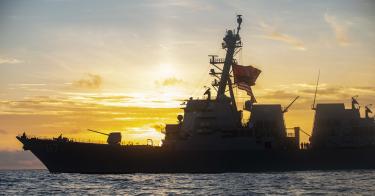The Navy budget proposal released last month seems an exercise in cognitive dissonance. Not only does it fail to acknowledge the obvious dangers of the present day, it further defers making good on long-overdue commitments to meet the threats of tomorrow.
Take a look around. Russia recently conducted large naval drills around Ukraine. Chinese aircraft and warships are busily trying to intimidate Taiwan and bully Philippine fishermen in the South China Sea. All the while, Beijing assiduously has been expanding its navy at breakneck pace.
To meet these aggressive Chinese and Russian behaviors, the United States should push to recapitalize its naval infrastructure, invigorate lackluster shipbuilding, and build needed end-strength. Unfortunately, the Navy budget proposed by the Biden administration does none of this. Instead, it shunts money from the field to the lab (R&D increases 12 percent over last year while overall procurement drops 8 percent) and busies itself with re-education.
The president’s proposal disappoints on several counts, starting with shipbuilding.
>>> Biden Administration Is Forcing the Navy to Make a False Choice
Last year, the Navy sought and got Congressional authority to make a cost-saving block buy of four amphibious ships. Instead of honoring that commitment, the proposed budget would purchase none of those ships—a move that would further complicate the shipbuilding industry’s efforts to remain solvent and undermine good faith with Congress.
Overall, this budget proposes a $2 billion cut to warship construction. The Navy was already struggling to meet the Obama-era goal, supported by President Trump, of building a 355-ship fleet by 2034. It today has only 296 warships instead of the scheduled 308. The proposed cut would put the re-building program even further behind. [Note: The Biden administration has yet to make clear its position on fleet size. Congress, however, still has as policy the earlier 355-ship goal. (See Sec. 1025 of the 2018 defense authorization act.)
The budget also inexplicably cuts sailors, reducing manpower by 1,600 even though the end-strength must grow by 27,712 to man the 355-ship fleet. Yet, the same week the administration proposed these cuts, the Government Accountability Office reported that persistent crew manning shortfalls—as high as 15 percent on some ships—was producing widespread crew fatigue. Fatigue was a contributing factor to two fatal collisions in 2017.
At a time when inflation is surging above four percent, the administration proposes a paltry 2.7 percent pay raise. This would surely compound the difficulty of attracting people to the Navy—especially when you consider that we will need additional sailors to man a larger fleet by 2034.
The training budget is also problematic. It prioritizes sexual assault prevention training—a noble effort, but one that has thus far not succeeded in producing the desired results. Moreover, while it boosts the budget for sexual assault prevention and response, or SAPR, by $47 million, it shrinks higher education and entry level programs, such as the Reserve Officer Training Program, by $391 million.
And, it misses an opportunity to bring back BOOST—Broadened Opportunity for Officer Selection Training—as recommended in the February 3, 2021, Task Force One Navy report, to improve accession of minority and underserved recruits who want to become naval officers.
Nothing in the proposed education and training budget indicates how the Navy will go about building a better understanding of the China threat with less resources—another instance of cognitive dissonance. After all, the Chief of Naval Operations’ January 2021 NAVPLAN states, “Our Naval Education Enterprise will incorporate more instruction about our adversaries into our professional military education curriculum.”
A rare area of increased funding is research and development, where the administration proposes $2.5 billion in new monies, a 12 percent increase over 2021. But this increase comes with no guarantee of delivery of weapons or platforms in the near-term—or ever.
>>> NATO Summit 2021: Alliance Needs Realistic Strategy for the Challenges of a Rising China
In short, the administration is doubling down on its bet that conflict will wait until sometime in the distant future. Yet all indications are that conflict is a scant few years away. Certainly that was the testimony of the current and last Indo-Pacific Commanders to the Senate Armed Services Committee this March.
Shipbuilding, recruitment, and training are long-lead elements of naval power. This budget delays tackling those challenges and turns a blind eye to the danger posed by China’s rapidly growing fleet of over 360 warships. The Navy’s false choice of investing in future capability misses the reality facing it today. America must invest in both growing today’s fleet in numbers and staying ahead of our competitors’ technologies.
Our national security demands that we sustain our critical network of allies and compete with China and Russia. The administration’s proposed Navy budget does neither. Let us hope Congress will act more responsibly and deliver a budget that responds to current challenges and the dangers ahead.
This piece originally appeared in Defense One




